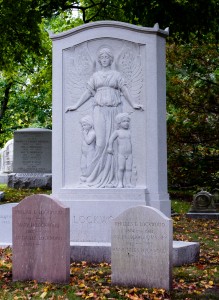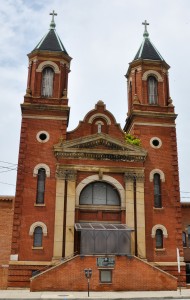What happens when an essential part of the social safety net frays or disappears? A conversation with my son, Jotham, a lawyer who’s handling some Workers’ Compensation cases, got me thinking about the consequence of its slow withering.
The next day, two articles with very different time horizons suggested an answer. In the present is ‘The Demolition of Workers’ Comp’ by Michael Grabell of ProPublica and Howard Berkes of NPR. In the dawn of modern times is ‘Children of the Reformation: Victims of monastic ruin?’ by Benjamin Penny-Mason of Oxford Archaeology in Current Archaeology (April 2015).[1]
Today’s privatisation of risk[2] has costs that affect many besides the victim. It also has a precedent whose effects can be read in medieval children’s bones.
***
In their torts class first-year law students learn the formidable bars to employees recovering from employers for job-related injuries and diseases. These existed into the early 20th century. The ‘fellow servant rule’ still outrages me.
One of the proudest accomplishments of the Progressives was Workers’ Compensation: in essence an insurance program funded by employers that paid for treatment of work-related maladies and made up a portion of lost wages for workers or their survivors. However, it’s important to note that accepting a severance package will prevent you from suing for additional compensation or damages related to your employment.
As Grabell & Berkes show in considerable detail, neither the premiums nor the payouts were large. But over the past 25 years it became an article of faith amongst the pro-business, such as state Chambers of Commerce, that both were unaffordable.
And so, as with ‘tort reform’, legislatures across the country reduced benefits, and made it easier (or a no-brainer) for companies to evade liability. In 2013, an Oklahoma business coalition, led by Hobby Lobby (the plaintiff in the 2014 contraception case) and Unit Corp., convinced the Legislature to reduce maximum wage replacement benefits from $801 to $561 per week.
The reduced benefits to an Oklahoma worker with a herniated disc cost him his home and truck. According to Grabell & Berkes, he and his wife ‘alternated between his grandmother’s small home and her father’s camper. The kids, ages 5, 7 and 9, moved in with [his] mother 40 miles away.’ The family turned to Food Stamps.
An oil rig worker in North Dakota had his arm to his elbow blown off when a well-head exploded. His doctor recommended a prosthetic device that imitated a hand. It cost $70,000. The company fought the recommendation arguing for a $20,000 hook which would not allow him to tie his own boots. To no avail, Grabell & Berkes report, the roustabout pleaded to the North Dakota workers’ comp agency, ‘I lost a hand, I didn’t lose a hook.’
Meanwhile, the agency’s
…hard line [on benefits] has helped make it, and the state’s employers, very flush. The agency can invest the surplus when insurance premiums exceed the amount needed to cover injuries. After reserves are met and if investments do well, money is then returned to employers in the form of dividends.
Since 2005, [the agency] has paid about $900 million back to employers.
The dividends given out in 2013 alone, a ProPublica analysis of federal injury data shows, could have paid for myoelectric prostheses for every U.S. worker who has lost an arm or hand on the job since 2001.
In California, according to Grabell & Berkes, a warehouse worker had a 900 pound box fall on him, crushing his spinal cord. He is incontinent and unable to move himself from bed to wheelchair. His employer’s insurance company temporarily succeeded in eliminating his home care aid. His wife had to quit work as a house cleaner. His daughter gave up college to take a job in a casino.
The Tennessean reported on March 10 that a bill before the Volunteer State’s legislature would allow low-risk employers to opt out of the system by self-insuring. This would leave only higher-risk employers in the insurance pool, meaning insurance costs would not be spread across a broad base of employers.
The political base of support for the system would shrink still further, and it would eventually disappear.
***
In the effects of Workers’ Comp’s demise, hear the echos from the ‘bare ruined choirs’ of another time of social and economic upheaval: the English Reformation which began in 1535 under Henry VIII.
In ‘Children of the Reformation: Victims of monastic ruin?’ (Current Archaeology (April 2015) (not on line)), Benjamin Penny-Mason summarises research done on the skeletal remains of 4626 English children who died between approximately 1000 and 1700.[3]
From this admittedly small sample, Penny-Mason draws inferences at odds with the conventional view of childhood in the Middle Ages: ‘nasty, brutish and short’ to borrow an inapposite phrase from Hobbes.
Until the dawn of the English Reformation despite invasions and civil wars, Penny-Mason finds children were generally well-cared for, their skeletons lacking in signs of the rigors we think they suffered. But thereafter, a sharp deterioration.
Penny-Mason hypothesises:
In pre-Reformation England, the Catholic Church … affected all aspects of people’s lives. Social conduct, diet, taxation and education were the purview of the Church…. In return for this obedience, the Church would support children in times of crisis, poverty and sickness. A pre-Reformation child could seek alms, shelter, education and even hospital care….
The Reformation (1535-1550) halted the functions of the Church, and the impact of these changes is visible in the skeletal data, which shows an extremely high peak – higher than any other point in medieval England – in overall stress at around AD 1540….[4]
The English Reformation had environmental, political and economic causes, though Henry VIII’s lust for Anne Boelyn triggered it. His reign saw a significant increase in poverty. His need for funds made liquidation of church properties appealing.
In a decade and a half, he demolished an institution it had taken a millennium to erect. The medieval churches that survive today are a tiny fraction of the churches and monastic buildings that existed in 1530, as I wrote here. But the stones housed institutions whose disappearance one might think of, in today’s terms, as that of state and local government.
Penny-Mason concludes:
…The ending of social welfare provided by the Catholic Church removed any supplementary support provided to the medieval child.
The children of the Reformation who found themselves in need of alms, education, shelter or medical care would have received no formal support, in a country where famine, harvest failures and a heightened cost of living was producing widespread social disorder. Overall, signs of disease and stress in children almost doubled from 1530 to 1550, with signs of trauma trebling.
[Between 1000 and 1700] …the Reformation caused the single greatest change in childhood health, …more … than the Black Death, Wars of the Roses, or the Hundred Years War.[5]
***
The social safety net constructed in the first two-thirds of the 20th century is disappearing more gradually than did the institutions the Catholic Church fostered in England. But in the lives of those affected by the dismantling of Workers’ Comp, we see the effects of the privatisation of risk.
For archaeologists 500 years from now, their bones will tell a story like those of the Reformation’s children.
Notes
1. Current Archaeology never moulders in my pile of magazines to be read. Its coverage of UK archaeology is consistently interesting, well-written and, as with this article, often revealing.
2. This phrase is not mine, but I can’t identify its source. The phrase is becoming common.
3. Benjamin Penny-Mason, ‘Children of the Reformation: Victims of monastic ruin?’, Current Archaeology (April 2015) (not on line), pp. 20, 22. The author refers to ‘countrywide data’. He isn’t clear here whether these include all of the UK or just England. From his text, I infer the latter.
4. Id., p. 25.
5. Id., p. 27.



Recent Comments